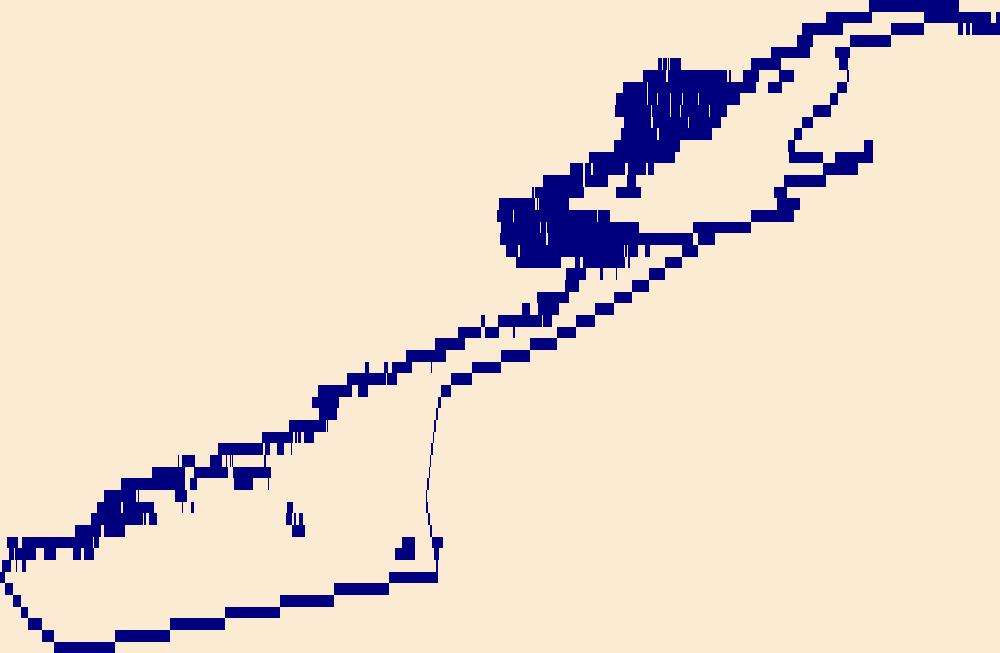Filters: Tags: Streamflow (X)
1,086 results (194ms)|
Filters
Date Range
Extensions (Less)
Types (Less)
Contacts (Less)
Categories (Less)
Tag Types
|
The U.S. Geological Survey (USGS), in cooperation with the New Mexico Water Resources Research Institute (WRRI), identified basin characteristics and estimated mean annual streamflow for a regional study of 169 USGS surface-water streamgages throughout the state of New Mexico and adjacent states. The basin characteristics and mean annual streamflows presented here will be used to derive equations for estimating mean annual streamflow at ungaged locations in New Mexico. The accompanying directories contain basin characteristics computation methods and results, and mean annual streamflow at streamgages. Using a Geographic Information System (GIS), surface-water streamgages were selected based on their location in...
This file (wymt_ffa_2021B_WATSTORE.txt) contains peak-flow input data for PeakFQ for peak-flow frequency analyses for selected streamgages based on data through water year 2021. The file format is called WATSTORE (National Water Data Storage and Retrieval System) available from NWISWeb (http://nwis.waterdata.usgs.gov/usa/nwis/peak).
Types: Map Service,
OGC WFS Layer,
OGC WMS Layer,
OGC WMS Service;
Tags: Bighorn,
Bighorn County,
Land,
Little Bighorn,
Lower Bighorn,
This dataset contains the daily average base flow, as determined by hydrograph separation, for 14 watersheds in Gwinnett County, Georgia for October 2001 through September 2020. Hydrograph separations were done using the Web-based Hydrograph Analysis Tool (WHAT) using the simple local minimum method on the daily average streamflows, which are also provided in this dataset. Base flow along with the calculated base-flow index (the proportion of base flow to total flow) were used to characterize groundwater recharge and the relative degree of storm runoff in the watersheds. Base flow was also used as predictor variable in models for estimating streamwater constituent loads for 12 water-quality constituents at 13 of...
Categories: Data;
Types: Map Service,
OGC WFS Layer,
OGC WMS Layer,
OGC WMS Service;
Tags: Gwinnett County,
State of Georgia,
datasets,
inlandWaters,
streamflow,
This data release contains a comma-delimited ascii file of five same-day, discrete discharge measurements made at sites along selected reaches of South Hālawa Stream, North Hālawa Stream, and Hālawa Stream, Oʻahu, Hawaiʻi on December 28, 2021. These discrete discharge measurements form what is commonly referred to as a “seepage run.” The intent of the seepage run is to quantify the spatial distribution of streamflow along the reach during fair-weather, low-flow conditions, generally characterized by negligible direct runoff within the reach. The measurements can be used to characterize the net seepage of water into (water gain) or out of (water loss) the stream channel between measurement sites provided that the...
Categories: Data;
Tags: Hālawa Stream,
North Hālawa Stream,
Oʻahu,
South Hālawa Stream,
State of Hawaii,
This dataset is a comma separated file of agricultural fields, ponds, surface diversions and wells used to generate the Agricultural package (AG).
Our objective was to model specific mean daily flow (mean daily flow divided by drainage area [cubic feet per second per square mile]) on small, ungaged streams in the Upper Colorado River Basin. Modeling streamflows is an important tool for understanding landscape-scale drivers of flow and estimating flows where there are no gaged records. We focused our study in the Upper Colorado River Basin, a region that is not only critical for water resources but also projected to experience large future climate shifts toward a drier climate.We used a random forest modeling approach to model the relation between specific mean daily flow on gaged streams (115 gages) and environmental variables. We then projected specific mean...
Our objective was to model specific minimum flow (mean of the annual minimum flows divided by drainage area [cubic feet per second per square mile]) on small, ungaged streams in the Upper Colorado River Basin. Modeling streamflows is an important tool for understanding landscape-scale drivers of flow and estimating flows where there are no gaged records. We focused our study in the Upper Colorado River Basin, a region that is not only critical for water resources but also projected to experience large future climate shifts toward a drier climate. We used a random forest modeling approach to model the relation between specific minimum flow on gaged streams (115 gages) and environmental variables. We then projected...
This data release contains inputs for and outputs from hydrologic simulations for the conterminous United States (CONUS) using the Precipitation Runoff Modeling System (PRMS) version 5.1.0 and the USGS National Hydrologic Model Infrastructure (NHMI, Regan and others, 2018). Historical simulations using the Maurer forcings (Maurer and others, 2002) were conducted for the period 1950-2010. This metadata record documents the simulation output files for simulations ran using the dynamic parameters file. The output files are aggregated at the HUC4 level and are grouped and downloadable by HUC2 hydrologic region. Each zip folder contains identical information, just for a different region and set of hydrologic response...
The continental United States (CONUS) was modeled to produce simulations of historical and potential future streamflow using the Precipitation-Runoff Modeling System (PRMS) application of the USGS National Hydrologic Model Infrastructure (NHMI; Regan and others, 2018). This child page specifically contains atmospheric forcings (daily minimum air temperature, daily maximum air temperature, and daily precipitation accumulation) from each of the global circulation models (GCMs) presented in table1_GCMs_used.csv, using the Representative Concentration Pathway 4.5 for simulating potential future streamflow for the period 2006 - 2100.
This data release contains monthly 270-meter gridded Basin Characterization Model (BCMv8) climate inputs and hydrologic outputs for Santa Clara River Valley South Bay (SCVSB). Gridded climate inputs include: precipitation (ppt), minimum temperature (tmn), maximum temperature (tmx), and potential evapotranspiration (pet). Gridded hydrologic variables include: actual evapotranspiration (aet), climatic water deficit (cwd), snowpack (pck), recharge (rch), runoff (run), and soil storage (str). The units for temperature variables are degrees Celsius, and all other variables are in millimeters. Monthly historical variables from water years 1896 to 2019 are summarized into water year files and long-term average summaries...

This dataset, termed "GAGES II", an acronym for Geospatial Attributes of Gages for Evaluating Streamflow, version II, provides geospatial data and classifications for 9,322 stream gages maintained by the U.S. Geological Survey (USGS). It is an update to the original GAGES, which was published as a Data Paper on the journal Ecology's website (Falcone and others, 2010b) in 2010. The GAGES II dataset consists of gages which have had either 20+ complete years (not necessarily continuous) of discharge record since 1950, or are currently active, as of water year 2009, and whose watersheds lie within the United States, including Alaska, Hawaii, and Puerto Rico. Reference gages were identified based on indicators that they...
Types: Map Service,
OGC WFS Layer,
OGC WMS Layer,
OGC WMS Service;
Tags: Alabama,
Alaska,
All 50 states,
Arizona,
Arkansas,

The High Resolution National Hydrography Dataset Plus (NHDPlus HR) is an integrated set of geospatial data layers, including the National Hydrography Dataset (NHD), National Watershed Boundary Dataset (WBD), and 3D Elevation Program Digital Elevation Model (3DEP DEM). The NHDPlus HR combines the NHD, 3DEP DEMs, and WBD to a data suite that includes the NHD stream network with linear referencing functionality, the WBD hydrologic units, elevation-derived catchment areas for each stream segment, "value added attributes" (VAAs), and other features that enhance hydrologic data analysis and routing.

The High Resolution National Hydrography Dataset Plus (NHDPlus HR) is an integrated set of geospatial data layers, including the National Hydrography Dataset (NHD), National Watershed Boundary Dataset (WBD), and 3D Elevation Program Digital Elevation Model (3DEP DEM). The NHDPlus HR combines the NHD, 3DEP DEMs, and WBD to a data suite that includes the NHD stream network with linear referencing functionality, the WBD hydrologic units, elevation-derived catchment areas for each stream segment, "value added attributes" (VAAs), and other features that enhance hydrologic data analysis and routing.
A dye tracer study was completed on the lower Sandusky River between July 11-13, 2017, during a confirmed Grass carp (Ctenopharyngodon idella) spawning event downstream of Ballville Dam near Fremont, Ohio. The data contained in this data release include three-dimensional water-velocity data and discharge measurements collected using acoustic Doppler current profilers (ADCPs) deployed from two U.S. Geological Survey (USGS) survey boats stationed on the river during the study. Each boat was equipped with a 1200 kHz Teledyne RDI Rio Grande ADCP and differential Global Positioning System (GPS) receiver with sub-meter accuracy in horizontal position using the Wide Area Augmentation System (WAAS) differential correction....
The U.S. Geological Survey's (USGS) SPAtially Referenced Regression On Watershed attributes (SPARROW) model was used to aid in the interpretation of monitoring data and simulate streamflow and water-quality conditions in streams across the Southwestern Region of the Unites States. SPARROW is a hybrid empirical/process-based mass balance model that can be used to estimate the major sources and environmental factors that affect the long-term supply, transport, and fate of contaminants in streams. The spatially explicit model structure is defined by a river reach network coupled with contributing catchments. The model is calibrated by statistically relating watershed sources and transport-related properties to monitoring-based...
Categories: Data Release - Revised;
Types: Map Service,
OGC WFS Layer,
OGC WMS Layer,
OGC WMS Service;
Tags: Arizona,
California,
Colorado,
Hydrology,
Idaho,
The dataset has basin characteristics (drainage area, land use, and reservoir storage), parameters for a relation between streamflow and velocity, and travel time metrics at 100 gaged sites in the southeastern United States.
Categories: Data;
Tags: Hydrology,
Land Use Change,
USGS Science Data Catalog (SDC),
United States,
Water Quality,
Ecological flow (EFlow) statistics have been designated to characterize the magnitude, frequency, and duration of extreme high- and low-flows, the timing of seasonal flows, and the consistency of the historic regime. This Child Item contains a table of 178 EFlows for the time periods 1940-1969, 1970-1999, and 2000-2018, with absolute and percent change between periods, where applicable. Statistics were computed by Water Year (WY) for all 178 metrics and absolute and percent change were calculated by comparing metrics between combinations of two of the three time periods (1940-1969 and 1970-1999; 1940-1969 and 2000-2018; 1970-1999 and 2000-2018). Streamgages from the original dataset (n = 409) were excluded from...
Categories: Data;
Types: Map Service,
OGC WFS Layer,
OGC WMS Layer,
OGC WMS Service;
Tags: Chesapeake Bay Watershed,
Delaware,
EFlow,
EFlow statistics,
EGRET,
The USGS Wyoming-Montana Water Science Center (WY–MT WSC) completed a report (Sando and McCarthy, 2018) documenting methods for peak-flow frequency analysis following implementation of the Bulletin 17C guidelines. The methods are used to provide estimates of peak-flow quantiles for 50-, 42.9-, 20-, 10-, 4-, 2-, 1-, 0.5-, and 0.2-percent annual exceedance probabilities (AEPs) for selected streamgages operated by the WY–MT WSC. This data release presents peak-flow frequency analyses for Elk Creek at Augusta, Montana,, that were based on methods described by Sando and McCarthy (2018). Sando, S.K., and McCarthy, P.M., 2018, Methods for peak-flow frequency analysis and reporting for streamgages in or near Montana based...
Categories: Data;
Tags: Lewis and Clark County,
Montana,
annual exceedance probability,
hydrology,
peak-flow frequency,
The USGS Wyoming-Montana Water Science Center (WY–MT WSC) completed a report (Sando and McCarthy, 2018) documenting methods for peak-flow frequency analysis following implementation of the Bulletin 17C guidelines. The methods are used to provide estimates of peak-flow quantiles for 50-, 42.9-, 20-, 10-, 4-, 2-, 1-, 0.5-, and 0.2-percent annual exceedance probabilities (AEPs) for selected streamgages operated by the WY–MT WSC. This data release presents peak-flow frequency analyses for Elk Creek at Augusta, Montana, that were based on methods described by Sando and McCarthy (2018). Sando, S.K., and McCarthy, P.M., 2018, Methods for peak-flow frequency analysis and reporting for streamgages in or near Montana based...
Categories: Data;
Types: Map Service,
OGC WFS Layer,
OGC WMS Layer,
OGC WMS Service;
Tags: Montana,
USGS Science Data Catalog (SDC),
Water Resources,
annual exceedance probability,
hydrology,

The High Resolution National Hydrography Dataset Plus (NHDPlus HR) is an integrated set of geospatial data layers, including the best available National Hydrography Dataset (NHD), the 10-meter 3D Elevation Program Digital Elevation Model (3DEP DEM), and the National Watershed Boundary Dataset (WBD). The NHDPlus HR combines the NHD, 3DEP DEMs, and WBD to create a stream network with linear referencing, feature naming, "value added attributes" (VAAs), elevation-derived catchments, and other features for hydrologic data analysis. The stream network with linear referencing is a system of data relationships applied to hydrographic systems so that one stream reach "flows" into another and "events" can be tied to and traced...
|

|